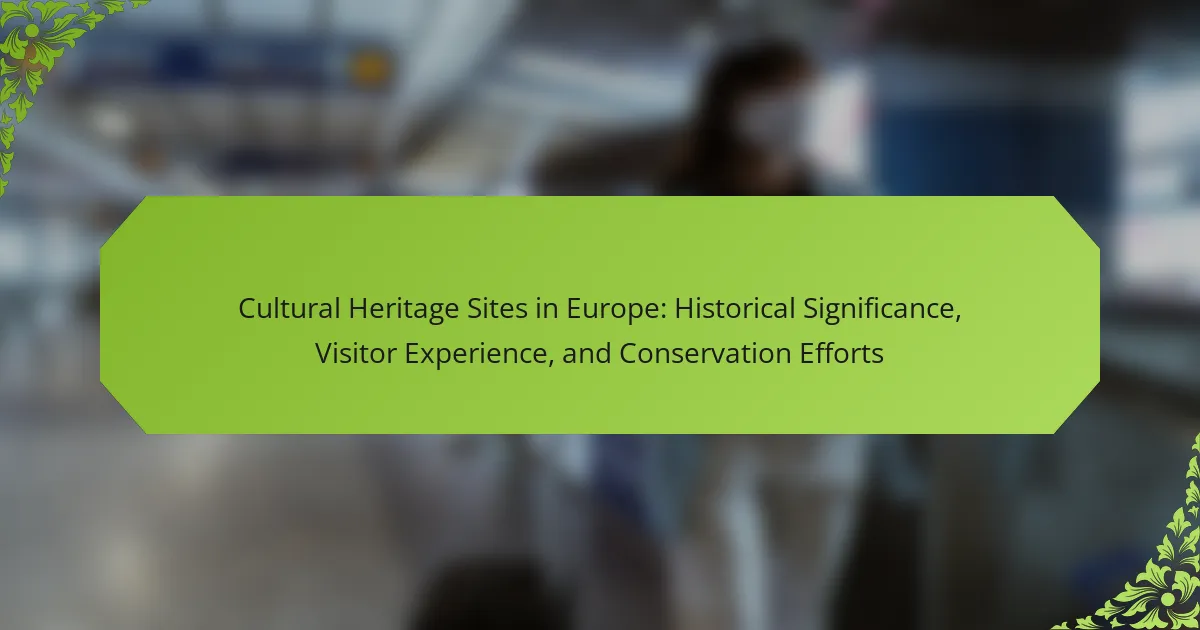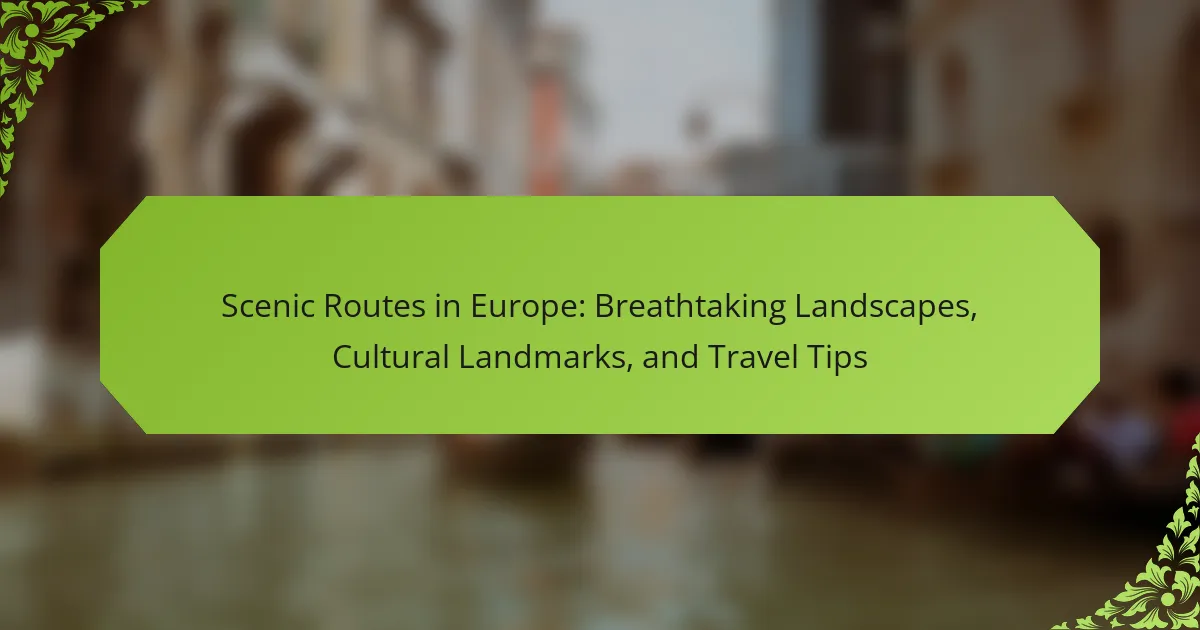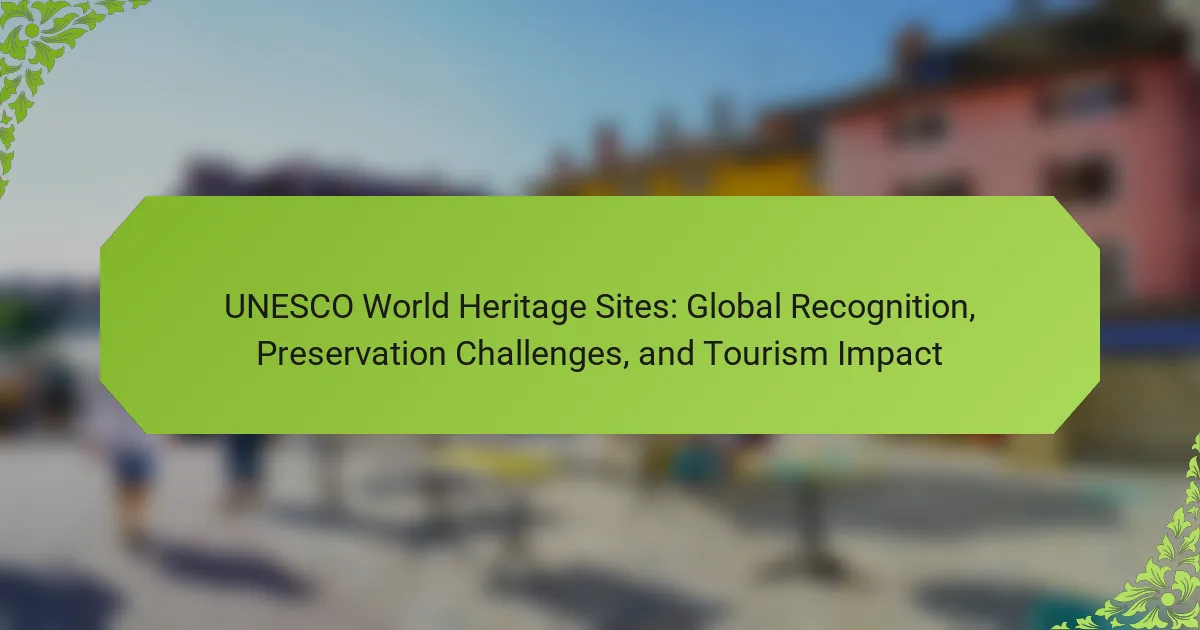Cultural heritage sites in Europe face challenges in preservation while offering rich historical narratives and unique visitor experiences. This article explores their historical significance, conservation efforts, and the role of sustainable tourism in maintaining these invaluable landmarks. Key examples include the Colosseum and Notre-Dame, highlighting diverse architectural styles and cultural practices. Understanding these aspects is essential for supporting the integrity of these sites for future generations.
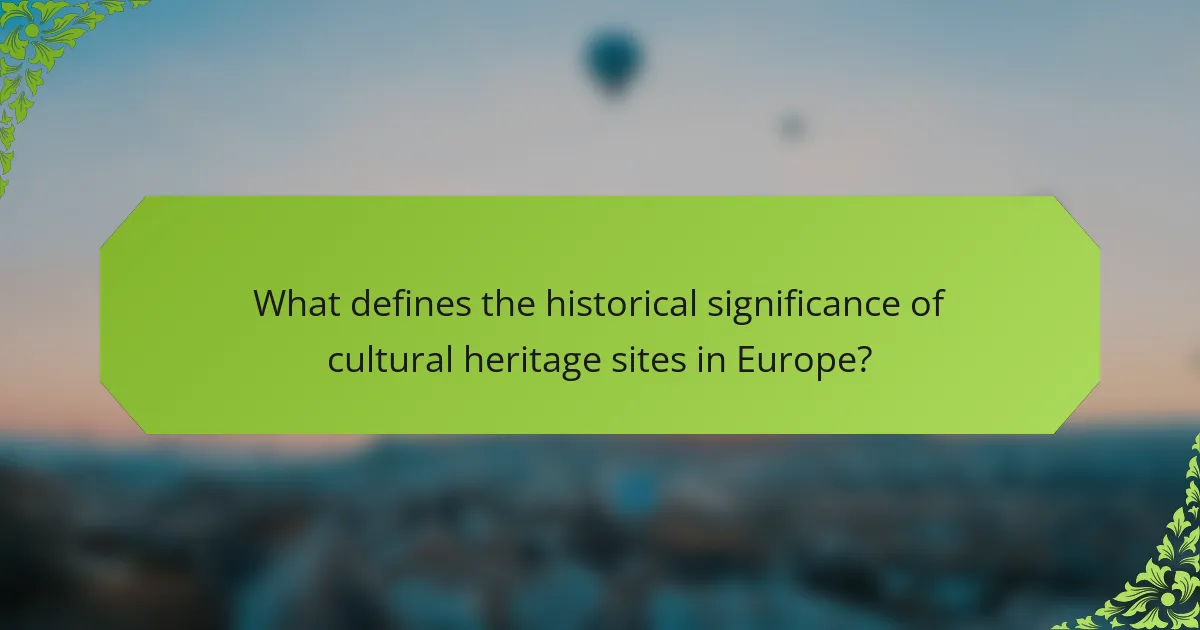
What defines the historical significance of cultural heritage sites in Europe?
Cultural heritage sites in Europe hold historical significance due to their rich narratives, architectural styles, and cultural practices. They represent collective memory, identity, and continuity across generations. These sites often reflect unique attributes, such as the Roman influence in structures like the Colosseum or the Gothic elements in cathedrals like Notre-Dame. The preservation of these sites fosters tourism, contributing to local economies while promoting education and cultural exchange. As a result, conservation efforts are vital to maintain their integrity for future generations.
How do cultural heritage sites reflect local traditions and identities?
Cultural heritage sites reflect local traditions and identities through architecture, rituals, and community narratives. These sites embody historical events and practices that shape local culture. For example, the Colosseum in Rome represents ancient Roman engineering and social life. Additionally, traditional festivals held at these sites celebrate unique customs, fostering a sense of belonging among residents. Conservation efforts ensure these sites remain preserved, allowing future generations to connect with their heritage. This connection reinforces local identity and promotes cultural continuity.
Which major historical events are represented by these sites?
Cultural heritage sites in Europe represent major historical events such as the Renaissance, the Industrial Revolution, and World War II. These sites include the Colosseum in Rome, reflecting ancient Roman history, and the Berlin Wall, symbolizing the Cold War’s impact. Other significant sites include the Palace of Versailles, showcasing royal power, and Auschwitz, representing the Holocaust’s tragedy. These locations offer visitors a profound connection to Europe’s complex history through their architecture, artifacts, and narratives.
How do these sites contribute to European unity and identity?
Cultural heritage sites in Europe foster unity and identity by celebrating shared history and diverse cultures. These sites serve as symbols of collective memory, promoting understanding among different nations. For instance, the Colosseum in Rome represents ancient Roman civilization, while the Acropolis in Athens highlights Greek achievements. Visitor experiences at these sites enhance cross-cultural exchanges, encouraging dialogue and appreciation of heritage. Conservation efforts further strengthen European identity by preserving these landmarks for future generations, reinforcing a sense of belonging and continuity within the continent.

What is the visitor experience like at cultural heritage sites in Europe?
The visitor experience at cultural heritage sites in Europe is often enriching and educational. Visitors engage with history through guided tours, interactive exhibits, and immersive environments. Many sites offer multilingual resources, enhancing accessibility for diverse audiences. Unique attributes, such as UNESCO World Heritage status, attract millions annually, contributing to local economies. Conservation efforts are vital in preserving these sites, ensuring they remain intact for future generations.
How do visitor demographics vary across different sites?
Visitor demographics at cultural heritage sites in Europe vary significantly based on location, historical significance, and conservation efforts. For instance, iconic sites like the Colosseum attract a diverse international audience, while lesser-known sites may draw more local visitors.
Key factors influencing demographics include age, with younger visitors often seeking interactive experiences, and educational background, as history enthusiasts tend to frequent sites with rich narratives. Seasonal variations also affect visitor numbers, with summer months seeing higher tourist traffic compared to off-peak seasons.
Additionally, conservation efforts play a role in shaping visitor experiences. Sites that prioritize sustainable tourism often attract visitors interested in responsible travel practices. This demographic shift highlights the growing importance of eco-consciousness among travelers.
Overall, understanding these demographic variations is crucial for enhancing visitor experiences and improving conservation strategies across Europe’s cultural heritage sites.
What are the most popular activities for visitors at these sites?
Visitors at cultural heritage sites in Europe commonly engage in guided tours, interactive exhibits, and local cuisine experiences. Many also participate in workshops, attend cultural performances, and explore surrounding landscapes. These activities enhance understanding of historical significance and foster appreciation for conservation efforts.
How do cultural heritage sites engage visitors through educational programs?
Cultural heritage sites engage visitors through immersive educational programs that enhance understanding and appreciation. These programs often include guided tours, workshops, and interactive exhibits that highlight historical significance.
For example, many sites offer hands-on experiences where visitors can participate in traditional crafts or reenact historical events. This unique attribute fosters a deeper connection to the culture being represented.
Additionally, educational programs often incorporate technology, such as augmented reality, to provide dynamic learning experiences. As a result, visitors gain insights into the conservation efforts and challenges these sites face today.
Overall, these initiatives not only educate but also inspire visitors to advocate for the preservation of cultural heritage.
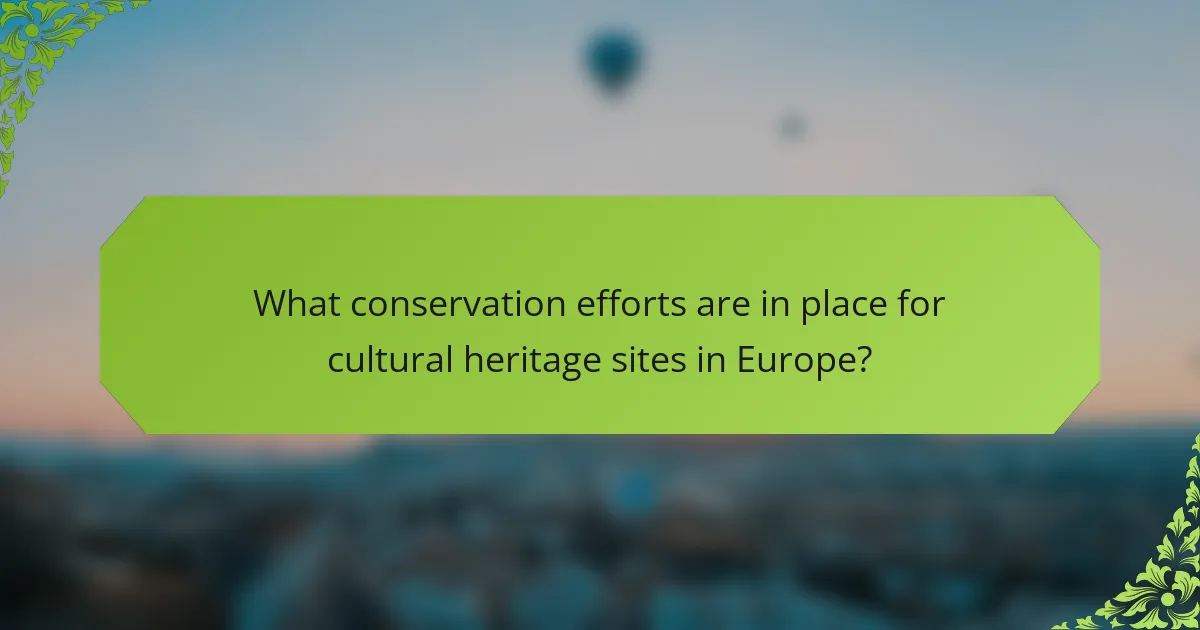
What conservation efforts are in place for cultural heritage sites in Europe?
Cultural heritage sites in Europe benefit from numerous conservation efforts aimed at preserving their historical significance. These initiatives include funding from governmental and non-governmental organizations, community involvement, and international collaborations. For instance, UNESCO’s World Heritage program plays a vital role in protecting sites like the Colosseum and the Acropolis. Additionally, local governments implement regulations to manage tourism and maintain site integrity. Technology, such as 3D scanning, aids in monitoring the condition of these sites, ensuring their preservation for future generations.
How do funding and policy impact conservation initiatives?
Funding and policy significantly influence conservation initiatives for cultural heritage sites in Europe. Financial support ensures that preservation efforts are adequately resourced, while policies establish frameworks for sustainable management.
Government grants and private investments are essential for maintaining these historical sites. For example, the European Union allocates substantial funds for heritage conservation, promoting tourism and local economies. Effective policy frameworks encourage collaboration among stakeholders, ensuring that conservation strategies align with community interests and environmental sustainability.
Moreover, policy initiatives can prioritize certain sites based on their historical significance or visitor experience, directing resources where they are most needed. As a result, a well-structured approach to funding and policy can enhance the effectiveness of conservation efforts, preserving Europe’s rich cultural heritage for future generations.
What role do local communities play in conservation efforts?
Local communities play a crucial role in conservation efforts for cultural heritage sites in Europe. They contribute local knowledge, foster stewardship, and promote sustainable tourism. Engaging communities ensures that conservation practices respect cultural significance and enhance visitor experiences. Additionally, local participation can lead to increased funding and resources for preservation initiatives.
Which innovative technologies are being used for site preservation?
Innovative technologies for site preservation include 3D scanning, drone surveying, and digital modeling. These methods enhance documentation accuracy and facilitate restoration efforts. For example, 3D scanning captures detailed spatial data, while drones provide aerial perspectives for large sites. Additionally, augmented reality aids visitor engagement by overlaying historical data on real-world views.
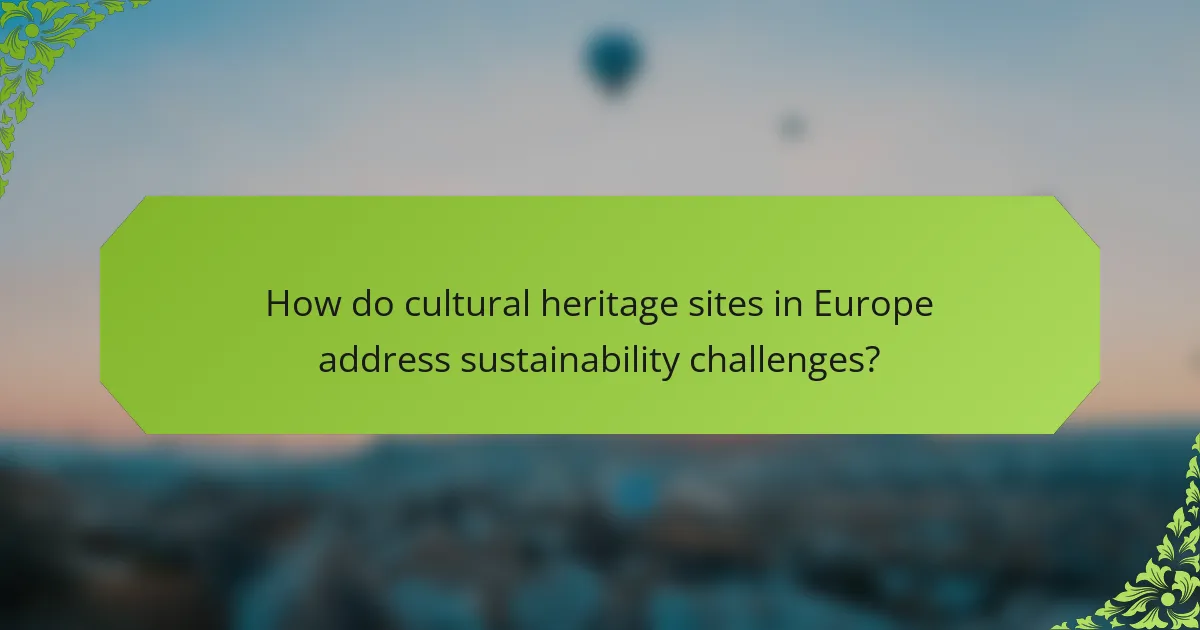
How do cultural heritage sites in Europe address sustainability challenges?
Cultural heritage sites in Europe tackle sustainability challenges through innovative conservation practices and community engagement. These sites implement eco-friendly technologies, promote responsible tourism, and collaborate with local stakeholders to preserve their historical significance. For instance, adaptive reuse of buildings and sustainable resource management are common strategies. Additionally, educational programs raise awareness about the importance of protecting cultural heritage, ensuring that future generations can appreciate these sites.
What strategies are implemented to minimize environmental impact?
Cultural heritage sites in Europe implement various strategies to minimize environmental impact. These include sustainable tourism practices, conservation technology, and community engagement initiatives.
Sustainable tourism practices focus on limiting visitor numbers and promoting eco-friendly transport options. For example, many sites now encourage walking or cycling tours.
Conservation technology includes using renewable energy sources and sustainable materials for restoration projects. This reduces energy consumption and waste generation during maintenance.
Community engagement initiatives involve local stakeholders in conservation efforts, fostering a sense of ownership and responsibility. This approach helps ensure that preservation efforts align with local values and needs.
How do sites balance tourism and preservation?
Cultural heritage sites balance tourism and preservation by implementing sustainable practices. These efforts include limiting visitor numbers, promoting responsible tourism, and investing in conservation projects. For instance, UNESCO guidelines encourage local community involvement in preservation, ensuring that cultural significance is maintained while enhancing visitor experience. Additionally, technology plays a role by using digital tools for virtual tours, reducing physical foot traffic.
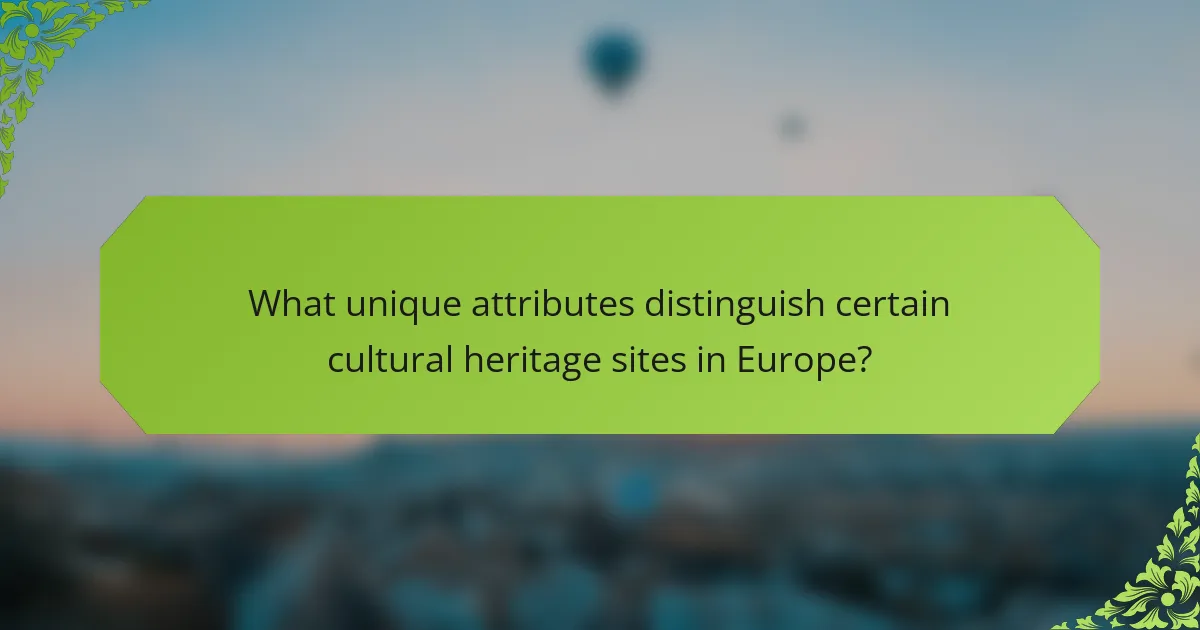
What unique attributes distinguish certain cultural heritage sites in Europe?
Cultural heritage sites in Europe are distinguished by unique attributes like architectural styles, historical narratives, and cultural significance. For instance, the intricate Gothic design of Notre-Dame de Paris sets it apart, while the ancient ruins of Pompeii offer a rare glimpse into Roman life. The preservation methods used also vary; some sites employ cutting-edge technology, while others rely on traditional techniques. These attributes enhance visitor experiences and contribute to ongoing conservation efforts.
Which sites feature rare architectural styles or artifacts?
Cultural heritage sites in Europe featuring rare architectural styles include the Alhambra in Spain, the Palace of Versailles in France, and the Neuschwanstein Castle in Germany. These sites showcase unique design elements and historical significance. The Alhambra features intricate Islamic architecture, while Versailles exemplifies French Baroque style. Neuschwanstein Castle is known for its romanticized medieval architecture. Each site offers visitors a distinct experience and highlights conservation efforts to preserve their unique attributes.
How do local myths and legends enhance the significance of specific sites?
Local myths and legends significantly enhance the importance of cultural heritage sites by creating deeper connections between visitors and the locations. These narratives enrich the visitor experience, making the sites more memorable and engaging. For example, the legend of King Arthur adds allure to Tintagel Castle in Cornwall, drawing tourists eager to explore its mythical past. Furthermore, local stories often reflect historical events, providing context that fosters appreciation for the site’s cultural significance. As a result, myths and legends play a vital role in the conservation efforts by promoting tourism, which can help fund preservation initiatives.
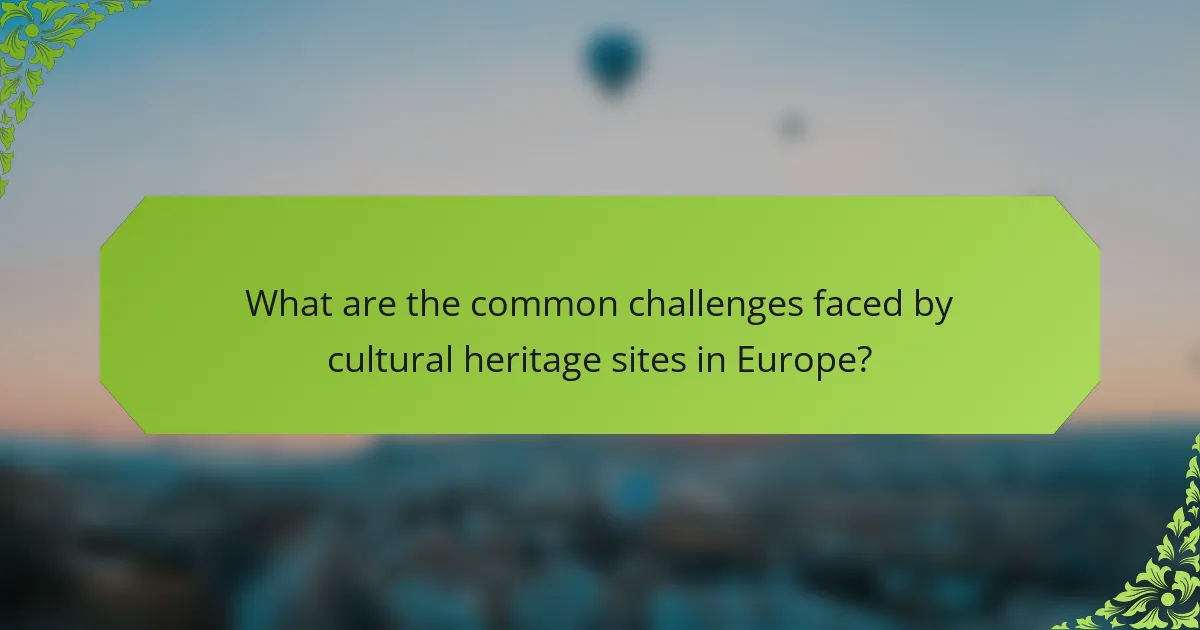
What are the common challenges faced by cultural heritage sites in Europe?
Cultural heritage sites in Europe face several common challenges, including funding shortages, environmental threats, and visitor management issues. These challenges hinder preservation efforts and affect visitor experiences.
Funding shortages often limit conservation projects, making it difficult to maintain and restore sites. Environmental threats, such as climate change and pollution, can cause significant damage to structures and landscapes. Visitor management issues arise from overcrowding, which can lead to wear and tear on fragile sites.
Additionally, the balance between tourism and preservation is crucial. Sites must attract visitors while protecting their historical integrity. Effective strategies are needed to address these challenges and ensure the longevity of cultural heritage in Europe.
How do political and economic factors affect site management?
Political and economic factors significantly influence site management for cultural heritage sites in Europe. Government policies can dictate funding levels for conservation efforts, while economic conditions affect visitor numbers and revenue generation.
Political stability promotes investment in site preservation, leading to enhanced visitor experiences. Conversely, economic downturns can result in reduced maintenance budgets, affecting site conservation and visitor satisfaction.
Additionally, regional policies may prioritize certain sites over others, impacting their management and conservation efforts. The interplay between these factors shapes the overall health and accessibility of cultural heritage sites.
What are the impacts of climate change on cultural heritage preservation?
Climate change significantly impacts cultural heritage preservation by threatening physical structures and altering visitor experiences. Rising temperatures and extreme weather events cause deterioration of materials, affecting historical sites across Europe. For instance, increased rainfall can lead to erosion and flooding, compromising site integrity. Additionally, changing climate patterns may disrupt traditional conservation methods, necessitating new approaches. The loss of biodiversity also impacts cultural landscapes, diminishing the historical context of these sites. Conservation efforts must adapt to these challenges to ensure the preservation of cultural heritage for future generations.

What best practices can be adopted for visiting and supporting cultural heritage sites?
To support cultural heritage sites effectively, visitors should adopt responsible practices that enhance preservation. Respect site regulations and guidelines to protect the integrity of these locations. Engage with local communities to understand their cultural significance and support their efforts.
Consider sustainable tourism options that minimize environmental impact. Participate in guided tours led by knowledgeable locals to gain deeper insights into the history and cultural context. Lastly, contribute to conservation initiatives through donations or volunteer work, ensuring these heritage sites remain preserved for future generations.
How can visitors contribute to conservation efforts during their visit?
Visitors can contribute to conservation efforts by participating in local programs, following guidelines, and making eco-friendly choices. Engaging with volunteer opportunities helps preserve cultural heritage sites. Donations to preservation organizations further support these initiatives. Respecting site regulations protects the integrity of historical locations.
What tips can enhance the cultural experience for visitors?
To enhance the cultural experience for visitors at European cultural heritage sites, engage with local traditions, participate in guided tours, and explore interactive exhibits. These strategies deepen understanding and appreciation of historical significance.
1. Attend local festivals to immerse in authentic cultural practices.
2. Join guided tours led by knowledgeable locals for insights and stories.
3. Explore interactive exhibits that provide hands-on learning experiences.
4. Taste regional cuisine to connect with the local culture.
5. Visit lesser-known sites to discover unique historical narratives.
6. Engage with local artisans to appreciate traditional craftsmanship.
